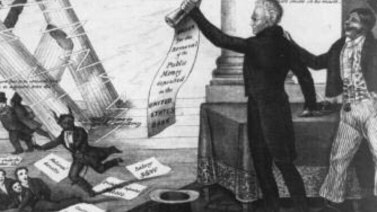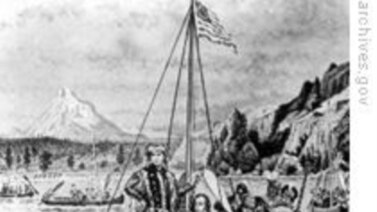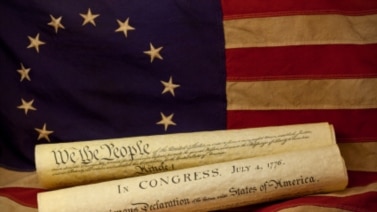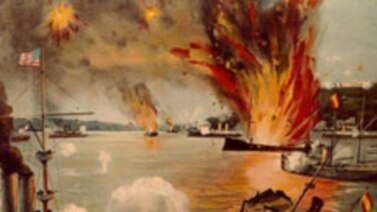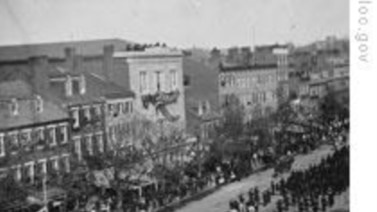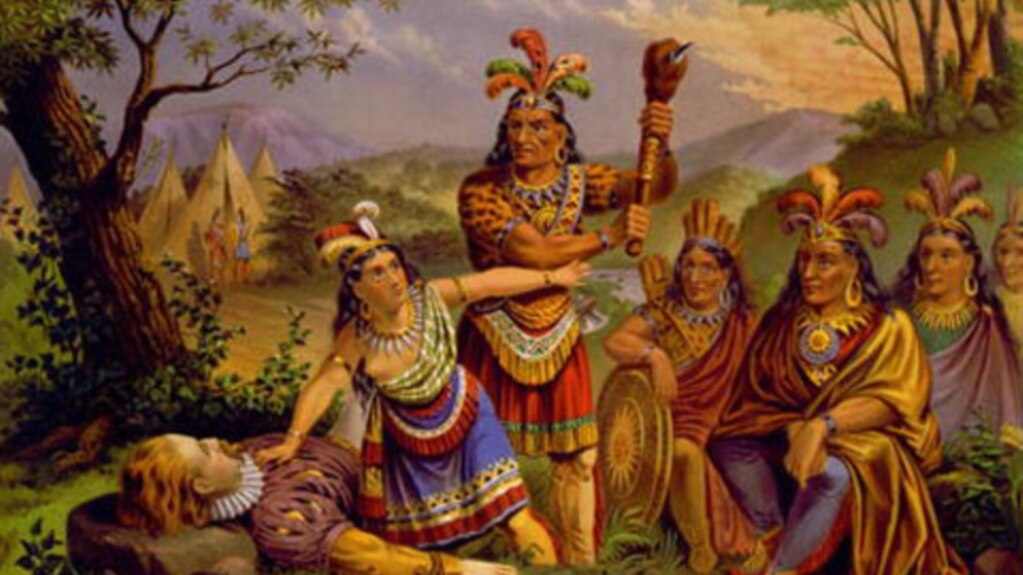
STEVE EMBER: Welcome to THE MAKING OF A NATION -- American history in VOA Special English. I’m Steve Ember.
Last week in our series, we talked about the voyages to the New World by Christoper Columbus and other explorers sailing for Spain and Portugal. Today, we tell the story of the first permanent English settlements in North America.
(MUSIC)
England was the first country to compete with Spain for claims in the New World. Queen Elizabeth the First supported explorations as early as the fifteen seventies.
Sir Humphrey Gilbert led the first English settlement efforts, but he did not establish any lasting settlement. He died as he was returning to England.
Gilbert's half-brother, Sir Walter Raleigh, continued the work. Raleigh sent a number of ships to explore the east coast of North America. He named the land Virginia in honor of Queen Elizabeth, who never married and was known as "the Virgin Queen."
(MUSIC)
In fifteen eighty-five, about one hundred men settled on Roanoke Island, off the coast of the present-day state of North Carolina. These settlers returned to England a year later. Another group went to Roanoke the next year. This group included a number of women and children. But the supply ships that Raleigh sent to the colony failed to arrive. When help got there in fifteen-ninety, none of the settlers could be found. At least some of the settlers may have become part of the Indian tribe that lived in the area.
(MUSIC)
One reason for the delay in getting supplies to Roanoke was the attack of the Spanish Navy against England in fifteen eighty-eight. King Phillip of Spain had decided to invade England. But the small English ships combined with a fierce storm defeated the huge Spanish fleet. As a result, Spain was no longer able to block English exploration.
England discovered that supporting colonies so far away cost a lot of money. So Queen Elizabeth took no more action to do it. Not until after her death in sixteen three did England begin serious efforts to start colonies in America.
(MUSIC)
In sixteen six, the new English King, James the First, gave two business groups permission to establish colonies in Virginia, the area claimed by England. Companies were organized to carry out the move.
The London Company sent one hundred settlers to Virginia in sixteen six. The group landed there in May, sixteen seven and founded Jamestown. It was the first permanent English colony in the new world.
The colony seemed about to fail from the start. The settlers did not plant their crops in time so they soon had no food. Their leaders lacked the farming and building skills needed to survive on the land. More than half the settlers died during the first winter.
(MUSIC)
The businessmen controlling the colony from London knew nothing about living in such a wild place. They wanted the settlers to search for gold, and explore local rivers in hopes of finding a way to the East. One settler knew this was wrong. His name was Captain John Smith. He helped the colonists build houses and grow food by learning from the local Indians. Still, the Jamestown settlers continued to die each year from disease, starvation and Indian attacks.
The London Company sent six thousand settlers to Virginia between sixteen six and sixteen twenty-two. More than four thousand died during that time.
Historians say that all the settlers surely would have died without the help of the local Powhatan Indians. The Indians gave the settlers food. They taught them how to live in the forest. And the Powhatan Indians showed the settlers how to plant new crops and how to clear the land for building.
The settlers accepted the Indians' help. Then, however, the settlers took whatever else they wanted by force. In sixteen twenty-two, the local Indians attacked the settlers for interfering with Indian land. Three hundred forty settlers died. The colonists answered the attack by destroying the native tribes living along Virginia's coast.
(MUSIC)
The settlers recognized that they would have to grow their own food and survive on their own without help from England or anyone else. The Jamestown colony was clearly established by sixteen twenty-four. It was even beginning to earn money by growing and selling a new crop: tobacco.
The other early English settlements in North America were much to the north, in what is today the state of Massachusetts. The people who settled there left England for reasons different from those who settled in Jamestown. The Virginia settlers were looking for ways to earn money for English businesses. The settlers in Massachusetts were seeking religious freedom.
(MUSIC)
King Henry the Eighth of England had separated from the Roman Catholic Church. His daughter, Queen Elizabeth, established the Protestant faith in England. It was called the Church of England, or the Anglican Church. The Anglican Church, however, was similar to the Roman Catholic Church.
Not all Protestants liked this idea. Some wanted to leave the Anglican Church and form religious groups of their own. In sixteen six, members of one group in the town of Scrooby did separate from the Anglican Church. About one hundred twenty-five people left England for Holland. They found problems there too, so they decided to move again -- to the New World.
These people were called pilgrims. Pilgrams are people who travel for religious reasons.
About thirty-five pilgrims were among the one hundred and two passengers and crew on a ship called the Mayflower in sixteen twenty. The Mayflower set sail from England, headed for Virginia. But the ship never reached Virginia. It was blown far off its planned course. Instead, it reached land far to the north, on Cape Cod Bay. The group decided to stay there instead of trying to find Jamestown, far to the south in Virginia.
(MUSIC)
They settled what would become the Massachusetts Bay Colony, They called the colony Plymouth, naming it after the harbor in England, from which they departed on their voyage to the New World.
The pilgrims and the others aboard the Mayflower believed they were not under English control since they did not land in Virginia. They saw the need for rules that would help them live together peacefully. They wrote a plan of government, which they called the Mayflower Compact. It was the first such plan ever developed in the New World.
They elected William Bradford as the first governor of the Plymouth Colony. We know about the first thirty years of the colony as William Bradford described it in his book, "Of Plymouth Plantation." It is also sometimes referred to as “William Bradford’s Journal.”
It actually tells the story of the Pilgrims from sixteen-eight, when they settled in the Netherlands through the Mayflower voyage, until the year sixteen forty-seven. It ends with a list, written in sixteen fifty, of Mayflower passengers and what happened to them.
(MUSIC)
As happened in Jamestown, about half the settlers in Plymouth died during the first winter. The survivors were surprised to find an Indian who spoke English. His name was Squanto. He had been kidnapped by an English sea captain and had lived in England before returning to his people.
The Pilgrims believed God had sent them Squanto. He made it possible for them to communicate with the native people. He showed them the best places to fish, what kind of crops to plant and how to grow them. He provided them with all kinds of information they needed to survive. The settlers invited the Indians to a feast in the month of November to celebrate their successes and to thank Squanto for his help. Americans remember this feast when they celebrate the holiday of Thanksgiving Day in November.
(MUSIC)
Other English settlers began arriving in the area now called New England. One large group was the Puritans. Like the pilgrims, the Puritans disagreed with the Anglican Church. But they did not want to leave the church. The Puritans wanted to change it to make it more holy in their view. Their desire for this change made them unwelcome in England.
The first ship carrying Puritans left England for America in sixteen thirty. By the end of that summer, one thousand Puritans had landed in the Northeast. Charles, the new English King, had given permission for them to settle in the Massachusetts Bay area.
The Puritans began leaving England in large groups. Between sixteen thirty and sixteen forty, twenty thousand sailed for New England. They risked their lives on the dangerous trip. They wanted to live among people who believed as they did.
The Puritans and other Europeans, however, found a very different people already living in the New World. They were the native Americans, or Indians, as Columbus called them, after thinking he had reached the East. That will be our story next week.
You can find our series online with transcripts, MP3s, podcasts and pictures at voaspecialenglish.com. You can also follow us on Facebook and Twitter at VOA Learning English. I’m Steve Ember, inviting you to join us again next week for THE MAKING OF A NATION -- American history in VOA Special English.
This was program #3
